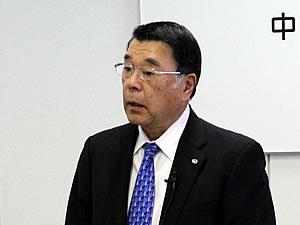2011年03月23日金子会長兼社長定例会見
会見要旨
(司会)
みなさまお待たせいたしました。ただいまから第65回の定例記者会見を始めさせていただきます。
(会長兼社長)

みなさんこんにちは。大震災の関係でお忙しい中、お集まりいただきまして誠にありがとうございます。
はじめに、このたびの東北地方太平洋沖地震により、お亡くなりになられた方々のご冥福をお祈り申し上げますとともに、被災されました皆さまに謹んでお見舞い申し上げます。
1日も早い復旧を心よりお祈り申し上げますとともに、NEXCO中日本グループとしましてもできる限りの支援をしてまいります。
すでに、NEXCO中日本管内では、被災地へ向かう緊急車両や物資の輸送車両など、行政や警察などが認めた車両に対する通行料金の無料措置を行っております。また、地震の被災者や福島第一原子力発電所付近から避難された方々に対し、物資の配送のためのトラック、タンクローリーを派遣するとともに、NEXCO東日本グループなどに対しては、標識車、発電車、給水車、食料品、飲料水などを支援しております。
被災地の1日も早い復興に役立てていただくため、NEXCO中日本グループ全体で、義援金を寄付することといたしました。サービスエリアやパーキングエリアでもお客さまからの義援金の受付を開始しておりますので、高速道路をご利用される皆さまのご協力をお願いいたします。
また、当社が発行しているプレミアムドライバーズカードでは、カード会員の皆さまがポイントを寄付金として交換できるサービスを開始しました。会員の皆さまに交換していただいたポイントは、「日本赤十字社」へ寄付いたします。カード会員の皆さまのご理解とご協力をお願い申し上げます。
さて、当社管内の高速道路や一般有料道路は、地震発生後の点検の結果、おかげさまで走行に支障のある被害はありませんでしたので、安心してご利用頂けます。地震発生後の通行止めの状況および地震前後の交通量の変化は、参考資料の2~3ページをご覧ください。
交通量は、地震発生後、全体的に減少しており、特に関東地方の落ち込みが激しくなっています。路線としましては、東名・中央道・長野道が減少している状況です。これは、関東方面への出控えに加え、ガソリン不足が拍車をかけて大幅に減少している一方、緊急車両や物資調達等の大型車両が新たに増えているという状況が複合的に影響している結果であると想定されます。
参考資料の6~7ページをご覧ください。電力不足に対する政府の方針を受け、当社としては、高速道路の一部の区間で、道路照明を消灯したりトンネル照明を暗くするなど、節電の協力を行っております。
高速道路をご利用いただく場合は、トンネル内の走行時や夕刻の早めの点灯など、安全に十分注意して走行していただきますようお願いします。
サービスエリアなどの休憩施設においても、駐車場やトイレ・商業施設の照明を暗くするなど節電に努めながら、災害支援や長距離運転の安全のために必要最低限での営業を継続しております。お客さまにはご迷惑をおかけしますが、足元に注意してご利用いただきますよう、ご理解とご協力をお願いいたします。
節電中や、計画停電の場合でも、自家発電による電力供給によりETC車と一般車はこれまでどおり料金所をご利用頂けます。計画停電が実施されている区域内の休憩施設は、規模の縮小や営業を休止する場合もありますが、お客さまに必要な商品を提供できるように努めております。ご不便をおかけしますが、お客さまのご理解を頂きますようお願いします。
また、サービスエリアなどにあるガソリンスタンドでは、現在、安定した燃料供給が困難な状況が続いております。そのため、NEXCO中日本エリア内のガソリンスタンドでは、給油制限を実施している所もあります。少しずつ状況は好転はしているものの予断を許さない状況ですので、高速道路をご利用いただく際には、燃料の残量を確認していただき、余裕をもった運転をお願いします。
なお、緊急車両並びに高速道路の維持管理に必要な車両に対し優先的な給油を実施しておりますので、ご理解・ご協力をお願いします。
最後になりますが、NEXCO中日本グループでは、被災された方々の雇用の確保に協力して参ります。NEXCO中日本グループ会社の料金収受業務を行っているエクストール名古屋およびエクストール横浜では、来年度の料金収受業務の社員として約400名を随時採用する計画です。当社管内の1都11県に避難された方が応募された場合は、できる限り優先的に採用していくことを考えております。詳細につきましては、各料金収受会社のホームページに掲載する予定です。
東北地方太平洋沖地震に関しては、以上です。
続きまして、2月の事業の現況です。
2月の料金収入は、321億9千5百万円と、対前年同月比0.6%減でした。内訳は、高速が299億2千5百万円、1.6%増、一有は22億6千9百万円、22.3%減となっています。
一方、2月の通行台数は、日平均186万8千台と、対前年同月比12.3%増でした。
内訳は、高速が日平均140万5千台、6.3%増、一有は46万3千台、35.5%増です。
通行台数については、一般有料道路を中心とした無料化社会実験による増加に加え、高速などの有料区間でも、昨年に比べ増加していることから、全体では、昨年比12.3%の増加となりました。一方、料金収入については、無料化社会実験の影響により、昨年比マイナスとなりました。
なお、今月のETC割引額は256億円で、前年同月の255億円に比べ、0.1%割引額が増加しています。割引率としては、約44.2%となります。
続きまして建設の状況です。
名古屋第二環状自動車道・名二環の名古屋南ジャンクションから高針ジャンクション間につきましては、並行する国道302号と合わせて、3月20日15時に予定どおり開通いたしました。
なお、開通式典につきましては、今回の東北地方太平洋沖地震の発生により、開催を見合わせて頂きました。
今回開通区間の交通量ですが、月曜日・春分の日の24時間交通量で約1万6千台のご利用を頂いております。
開通後1日のデータのみの比較ですが、東名高速の東名三好インターから日進ジャンクション間は、昨年同日に比べ約1万4千台減っていますが、伊勢湾岸自動車道も約1万4千台減少しており、震災等の影響による交通量の減が大きな要因ではないかと考えております。
また、名古屋高速3号大高線の断面交通量が、昨年同日に比べ約1万6千台減少しております。これは、震災の影響による交通量の減も考えられますが、交通の分散化が図られたと認識しているところです。
なお、今回は月曜日・春分の日、1日のみのデーターの動向であり、今後、震災等の影響も踏まえ、分析してまいりたいと考えております。
次に無料化社会実験区間を除くETCの利用状況です。直近の3/4~3/10は2/4から2/10と比較して、日平均利用台数は2.8%増、日平均利用率は88.8%から89.0%、0.2%増となっています。平日、土日休日別に見ると、平日平均利用率、土日休日平均利用率ともに、88.8%から89.0%、0.2%増となっています。
2月末の車載器取付け累計台数は、1月末と比較して0.8%増、台数にして27万台増加し約3,388万台です。
続きましてサービスエリアの状況です。
2月のサービスエリアの売上高は106億7千6百万円と、対前年比109.4%でした。道路別に見ると、特に東名阪道が140.7%、紀勢道131.4%と好調でした。
東名阪道では、『EXPASA(エクスパーサ)御在所』がグランドオープンから約半年が経過しましたが、引き続き多くのお客さまにご好評いただいており、紀勢道は無料化社会実験による影響と考えています。
売上を部門別に分けると、「飲食・物販部門」は、対前年比108.3%で6億1千7百万円増でした。
「飲食・物販部門」の更なる内訳は、「飲食部門」が対前年比106.7%で1億7千9百万円増、「物販部門」が対前年比109.3%で4億3千8百万円増となっております。続いて、「サービス部門(レストイン、風呂)」では、対前年比120.9%で5百万円増であり、「GS部門」は、給油数量が対前年比106.5%と昨年度を上回り、単価差もプラス9円あることから、売上高でも対前年比112.7%で2億9千5百万円増となっています。
以上が2月の事業の現況です。
次に新料金に関してですが、昨日の国土交通大臣のお話では、本日中に指針を出されると聞いていますが、本日2時現在、まだ私の手元に情報が入っておりません。会見中にでも情報が入り次第、皆様にお伝えしたいと思います。
次のトピックは、名古屋大学での寄附講座のお知らせです。
NEXCO中日本は、名古屋大学と昨年5月に「包括的な連携推進に関する協定」を締結し、様々な連携を図っているところです。
連携の一環として、寄附講座の開設の協議を進めてきた結果、4月から大学院工学研究科の社会基盤工学専攻でNEXCO中日本の寄附講座を開設することになりました。
講座の名称は、『インフラ技術開発・移転講座(NEXCO中日本)』です。期間は今年4月から3年間を予定しています。
研究のテーマは大きく2つあり、1つは今後海外のインフラ整備事業に関わっていくための技術移転のあり方を研究するものです。これは高速道路に限らず、インフラ全般を扱っていきたいと考えています。もう1つは「道路構造物の長寿命化」です。当社は「百年道路計画」を推進しており、今後ますます進行する道路の老朽化に備え、その健全度を簡易かつ正確に把握する技術の確立を目指すものです。これら2つのテーマは、当社の今後の事業に密接に関わる内容であると共に今後の日本にとって意義あるテーマであると考えています。
なお、寄附講座の活動については、研究の進捗を見ながら適切な時期に情報発信していきたいと考えています。
次のトピックは環境に配慮した取り組みです。今回は「野鳥と高速道路との共生に向けて」です。
東名阪自動車道の弥富インターチェンジ、蟹江インターチェンジでは、高速道路の機能と安全を損なうことなく、サギの生息環境を保全し、サギと高速道路との共生を目的としたエコロードの整備を行っています。
2010年8月には、この取組を継続的に図ることを目的として「愛知県弥富野鳥園」「日本野鳥の会愛知県支部」と、連携・協力に関する覚書を締結しました。
さらにこの取り組みを広く知って頂くため、サギと高速道路との共生を図る必要性や方法などを解説した冊子、「高速道路がサギのすみかになったわけ -自然と人が共に生きていくために-」を制作しました。編集は、覚書のメンバーが行い、NEXCO中日本が発行しました。
冊子は、愛知県や三重県北部の小学校、図書館、児童館などにお配りして、環境教育などに役立てて頂くとともに、愛知県弥富野鳥園や日本野鳥の会愛知県支部が行う探鳥会や親子セミナーなどで積極的に活用していただきます。
当社は今後も引続き、エコロードづくりを推進いたします。
次のトピックはITSスポットサービスについてです。
NEXCO中日本では、国土交通省及び高速道路各社と連携して、ITS(高度道路交通システム)を用いたスマートウェイサービスの展開を図るために、準備を進めて参りましたが、このたび、機器の整備が整ったことから、今月末までに「ITSスポットサービス」の運用を開始することとなりました。
ITSスポットサービスとは、ETCと同じ通信技術を用いて、全国の高速道路を中心に設置された「ITSスポット」と自動車に搭載された「対応カーナビ」との高速・大容量通信により、広範囲の道路交通情報や安全運転支援などのサービスを提供するものです。当社としましても今後力を入れていきたい分野です。
この運用開始に先立ち、サービス内容をより深くご理解していただくため、報道関係機関の皆様方を対象とした「ITSスポットサービス」の説明会を行うこととしましたので、この機会に是非ご参加ください。実施時期は急ではございますが25日の金曜日、場所は一宮道路管制センターで行います。
皆さまのお手元に資料はお配りしていませんが、ひと言申し上げます。
今月はじめに、新聞などで報道されていますように、弊社社員が所得税法違反容疑で国税局から査察を受けていることについて、高速道路をご利用いただいているお客さまをはじめとする、国民の皆様に、深くお詫び申し上げます。
弊社といたしましては、まずは事実関係の把握を最優先に進めており、国税局の調査にも全面的に協力しております。また、外部の専門家の協力もいただき、必要な社内調査を鋭意続けているところです。
事実関係が明らかになった段階で、あらためて、お知らせいたします。
以上が、本日のトピックスです。
(司会)
それでは、皆様からのご質問をお受けしたいと思います。
(記者)
地震発生後交通量などのデータを頂いていますが、今後の料金収入や交通量についてどのように予測されているのでしょうか?
(会長兼社長)
地震発生後の交通量データはお手元の資料のとおりですが、今しばらくは交通量減少の状況が続いていくのではないかと思います。要因のひとつは出控え、もうひとつは車のガソリンが通常に供給されていないことではないかと推測されます。徐々に回復はすると思いますが、交通量の減少は当面続いていくと思います。
(記者)
4月以降の新たな料金について、現段階で国の方針が決定していませんが、方針が決まりましたらコメントを頂けないでしょうか?
(会長兼社長)
分かりました。
(記者)
地震の関係で2点確認させてください。1点目は社長からご説明いただきました、雇用での支援について、募集がいつからで雇用体系がどのようになっているのかなどを詳しく教えてください。2点目は計画停電についてですが、夏に向けて更に供給が厳しくなってくると思いますが、今実施されている消灯や減灯はこれからどのように運用されていくのかの見通しを教えてください。
(会長兼社長)
雇用に関しては、先ほど約400名といいましたが、詳細には、エクストール名古屋で260名、エクストール横浜で130名、合計390名になります。募集はこの4月からの募集になり、一気に400名とはいきませんが、1年間かけて、順次雇用してまいりたいと思っています。詳細はそれぞれの会社のホームページに今後掲載される予定です。
計画停電に関しては、東京電力エリアに位置する休憩施設で節電を実施しており、お客さまにご不便をおかけしております。ご理解をお願いいたします。また、今後、特に夏場に向けての対応が重要であると考えておりまして、どのように対処していくのかを早急に検討して参ります。
(記者)
エクストールの雇用の件ですが、どのような思いで支援をされるのか教えて下さい。
(会長兼社長)
被災地の現状をみていると、我々の会社として何らかの支援を差しのべたい、その1つに尽きると思います。名古屋からではやれることに限りがありますが、できるかぎりの支援をしたい、その一環としての雇用ということで、我々のできることの1つであると考えてます。
(記者)
それはこちらに避難してきた方が対象ですか?
(会長兼社長)
そうです。すでに愛知県にも何人かの方が避難されていると聞いています。愛知県だけでなく、当社の事業エリアに避難して来られた方が対象ということです。
(記者)
地震のあと、1週間程度の通行台数、日平均、料金収入など出せる範囲でお願いします。
(会長兼社長)
お手元の資料の4ページに、地震後の第1週と第2週の交通状況があります。例えば右下の方に、東名の横浜町田IC~厚木ICのグラフがあります。左のグラフが下りで3/15から3/22で9%減っています。台数で4,700台減っています。同じ区間の上りは1%増加となっています。地震直後は30%近く落ち込みましたが、それから少し戻ってきたという感じです。
資料の3ページは、同じ東名の横浜町田IC~厚木ICで、下りが20%、上りが18%の減少です。中央高速も下りが21%の減少、上りが16%の減少です。これは3/8との比較ですから、地震の直前と直後です。資料の4ページは3/15との比較ですので、地震直後の落ち込みから少しずつ改善しているという状況です。
(記者)
今回、世界最大級の地震がおきましたが、NEXCO中日本として、東海地震や東南海地震については当然対策をされている中で、今回の地震発生を受け東名高速の安全管理のために見直しが必要という認識はありませんか?
(会長兼社長)
改めて何か見直しをするということはありません。当社管内では、昨年は台風9号によって東名が被災を受けてますし、一昨年も牧之原で被災しています。ですので、仮に今回のような被災があったときには、体制はできていると思います。しかし、社内的にはいくつか反省点もございます。今回の地震直後における社内の組織や指揮・命令系統について、今回私は東京にいて本社にいなかったので分かったのですが、私自身で改善しないといけない点を肌で感じたところがいくつかあります。そういった点は、これを機に改善をしていこうと考えています。
(記者)
危機管理のところで、改善点があるとおっしゃいましたが、可能な範囲でどのようなことを感じたのか具体的に1つでも2つでも教えてもらえますか?
(会長兼社長)
BCPです。今回の地震が起こった直後の体制・災害に対する対策、社内の体制の立ち上げ方、連絡網、携帯が通じない状況での通信手段などです。それから、その時どこに集まるか、当日は幹部がそれぞれの勤務地で仕事をしておりましたので、そのような中でどうやって一本化した体制を作り、その体制のもとによる指揮・命令系統をどうやって瞬時に確立するかということ、さらにスピード感です。社内のことですが、少々遅れたのでそれが大きな反省点になります。
(記者)
資料の6~4ページに、地震発生前後の断面通行量が出てますが、3/15東名高速の横浜町田~厚木の上りの通行量は増えているのに下りは減っている状況について、この分析についてはどのようにされていますか?
また、東名高速全体で見たときに、地震の前後で通行台数がトータルで増えているのか減っているのかどうか、資料は火曜日どうしの比較ですが1週間を通したときのデータはありませんか?
(会長兼社長)
1番目のご質問ですが、下りが減っているのは出控えだと思います。上りが増えているのは、東日本方面への応援等があると思います。担当から少し補足説明をお願いします。
(社員)
交通量の状況につきましては、地震直後の東名・中央道の首都圏近郊では、地震前と比べて約3割ほど交通量が落ち込んでいます。その後、徐々に回復し、3/22の昨日時点では地震前と比べて約2割の減少に回復してきています。具体的な交通量は、3/22の東名高速横浜町田IC~厚木IC間で、上り48,900台、下り46,200台という状況です。
また、資料の3ページの棒グラフですが、赤色が小型車、青色が大型車です。赤色が小型車で、一般的に出控え、あまり出歩かないので減少しております。青色の大型車については、被災地への支援等がかなり増えているので、あまり減少傾向にないといえます。
地震が起きてから2週間弱でして、今後も若干交通量は増加傾向になると思いますが、まだ地震前に回復する時点がいつ頃なのかということまでは分析しておりません。
(記者)
全体の話がありませんが、断面の交通量しかないですか?
(社員)
現段階では、各IC間の断面交通量しかありません。
(記者)
料金収入はありませんか?
(社員)
現段階ではありません。
大まかにいえば、中部地域(特に愛知、三重、岐阜付近)と北陸道より西側については、現地点でもあまり交通量の変動は起きていません。現時点では通年どおりです。
(記者)
首都圏で一時3割減少したのが2割減少に戻ってきているとの説明でしたが、3ページの表は2割減となっています。3割減という表記はありませんが、これは首都圏中心部にいけば3割減のところがあるという意味ですか?
(社員)
地震が起きてから日がまもないころは3割減ということです。本日お示ししている3/22の状況は2割減ということです。
(記者)
今週から回復してきたということでしょうか?
(社員)
そのとおりです。
(記者)
先ほど金子社長は地震対策を改めてすることはないとおっしゃいましたが、津波の対策はどのように考えていますか?
(会長兼社長)
特定の津波については考えておりませんが、東名高速の由比がありますので、まずはすみやかに通行止めをするということです。津波対策については、今は特別にプランをもっていません。ただし、今後検討していかないといけないと思っています。
(記者)
今までも津波の予測をして対策をしてきたが、今回想定外の大きな地震があったので、改めて検討するということでよろしいでしょうか。
(会長兼社長)
そのとおりです。
(司会)
以上で定例記者会見を終了いたします。

